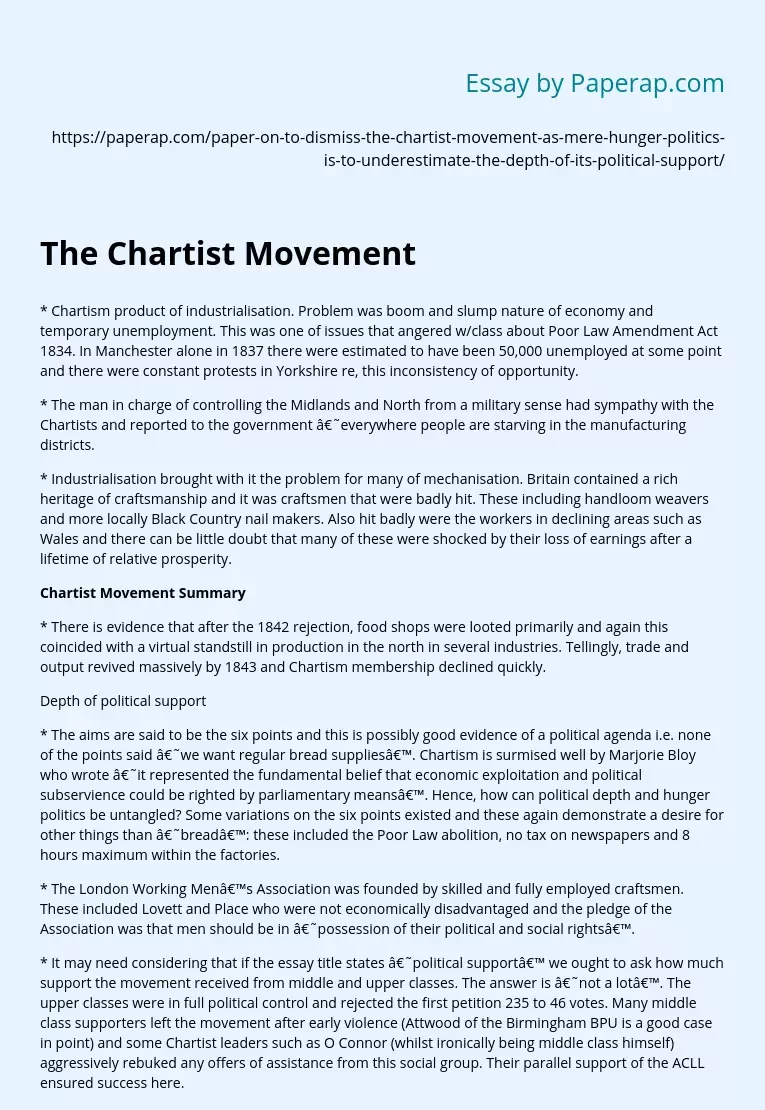The Chartist Movement Summary
Chartism product of industrialisation. Problem was boom and slump nature of economy and temporary unemployment. This was one of issues that angered w/class about Poor Law Amendment Act 1834. In Manchester alone in 1837 there were estimated to have been 50,000 unemployed at some point and there were constant protests in Yorkshire re, this inconsistency of opportunity.
The man in charge of controlling the Midlands and North from a military sense had sympathy with the Chartists and reported to the government ‘everywhere people are starving in the manufacturing districts.
Industrialisation brought with it the problem for many of mechanisation. Britain contained a rich heritage of craftsmanship and it was craftsmen that were badly hit. These including handloom weavers and more locally Black Country nail makers. Also hit badly were the workers in declining areas such as Wales and there can be little doubt that many of these were shocked by their loss of earnings after a lifetime of relative prosperity.
There is evidence that after the 1842 rejection, food shops were looted primarily and again this coincided with a virtual standstill in production in the north in several industries.
Tellingly, trade and output revived massively by 1843 and Chartism membership declined quickly.
The aims are said to be the six points and this is possibly good evidence of a political agenda i.e. none of the points said ‘we want regular bread supplies’. Chartism is surmised well by Marjorie Bloy who wrote ‘it represented the fundamental belief that economic exploitation and political subservience could be righted by parliamentary means’.
Hence, how can political depth and hunger politics be untangled? Some variations on the six points existed and these again demonstrate a desire for other things than ‘bread’: these included the Poor Law abolition, no tax on newspapers and 8 hours maximum within the factories.
The London Working Men’s Association was founded by skilled and fully employed craftsmen. These included Lovett and Place who were not economically disadvantaged and the pledge of the Association was that men should be in ‘possession of their political and social rights’.
It may need considering that if the essay title states ‘political support’ we ought to ask how much support the movement received from middle and upper classes. The answer is ‘not a lot’. The upper classes were in full political control and rejected the first petition 235 to 46 votes. Many middle class supporters left the movement after early violence (Attwood of the Birmingham BPU is a good case in point) and some Chartist leaders such as O Connor (whilst ironically being middle class himself) aggressively rebuked any offers of assistance from this social group. Their parallel support of the ACLL ensured success here.
Many had sympathy with the Chartists grievances but would have balked at suggestions that they should seize power. General Napier mentioned above was an apologist for the government but this does not mean that he gave the Chartists ‘political support’.
Conclusion: Chartism was a political movement born of economic circumstances. The superficiality of its support is best illustrated by the fact that when the economic situation improved, membership declined rapidly. This support would not have declined so quickly if the political views were deeply felt.
The Chartist Movement Summary. (2019, Dec 05). Retrieved from https://paperap.com/paper-on-to-dismiss-the-chartist-movement-as-mere-hunger-politics-is-to-underestimate-the-depth-of-its-political-support/

